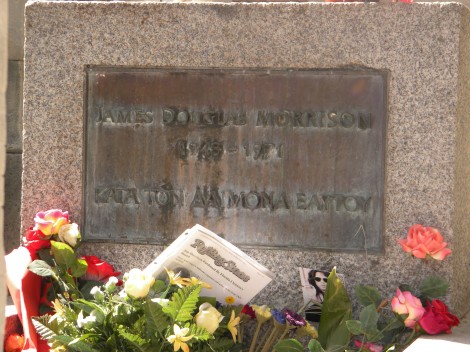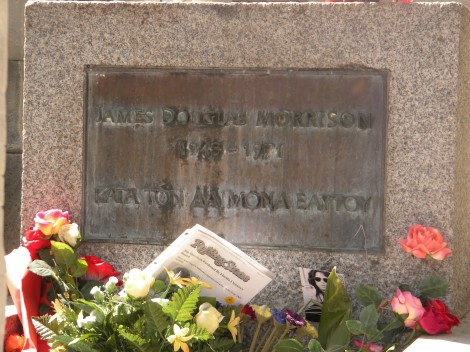REMEMBRANCE: Mr. Mojo Risin’ … 40 years later
PARIS – If it weren’t for all the notes of adulation in evocative graffiti, one could easily pass it by without a second glance. It lacks ornamentation and feels uncommonly ordinary, almost modest.
For such a controversial, extroverted singer, Jim Morrison’s grave is one of the most inconspicuous pilgrimage sites in the world. His small plot of land, sandwiched in between other more imposing, shadow-casting monuments, sits like an afterthought tucked away on a small hill in the gothic maze of the Cimetiere du Pere-Lachaise.

The massive complex of beautiful funereal architecture is located near the eastern outskirts of Paris in the 20th arrondissement, serving as the local neighborhood’s only historical carrot to grab tourists’ attention away from the Eiffel Tower, Arc de Triomphe and Notre Dame Cathedral.
And yet, despite its simplicity, this is where Mr. Mojo Risin’ eternally resides, and this is where the world comes to pay its respect, 40 years and counting.
His death at the age of 27 on July 3, 1971, garnered international attention and the requisite conspiracy theories about what happened and whether the news was true. Today, remembering the fortieth anniversary of his death, the deceased lead singer of the Doors still commands an audience of admirers.
Even though his Pere-Lachaise neighbors are some of literature’s most respected stalwarts, from the Bohemian crowd of Marcel Proust and Gertrude Stein to the erudite royalty of Collette and Moliere, Morrison’s grave seems to gather the most cell-phone snapshots. His magnetic power at the cemetery, some four decades after his death, might only be surpassed by Oscar Wilde and France’s legendary chanteuse, Edith Piaf, who are buried just up the hill from Morrison’s plot.
The singer of such classics as “L.A. Woman,” “Light My Fire” and “People Are Strange” is often cited as having lived life to the fullest, and his image somehow journeys on just as strongly as it did in the late 1960s. In December 2010, Morrison’s infamous exposure conviction in Florida was pardoned more than 40 years after the alleged incident. The Doors’ compilations continue to sell well, and Morrison’s growling lyrics are still musical fodder for radio stations, attracting the ears of fans, both new and old alike. Having died so young, he has entered that upper pantheon of legendary status, sharing a storied legacy with the likes of Jimi Hendrix and Janis Joplin.
Temporary metal barricades block off eager fans from getting too close and crossing the line from devotion to desecration. But still, it has proved to be an illegal, yet colorful, rite of passage to leave a message to Morrison with a marker or crayon. The artistic dedications spill out a few feet from his simple headstone, creating a makeshift shrine of candles and poetry, flowers and remembrances.
His actual marker simply reads “James Douglas Morrison, 1943-1971, Kata Ton Daimona Eaytoy,” a cryptic Greek message that likely means “True to his own spirit.” Often these words, rusted from decades of Parisian rain, are obscured by the tokens of appreciation left by adoring fans.
On a recent visit, security officials were standing nearby as devotees, maps in hand and water bottles at the ready, made their way up the central hill of Pere-Lachaise to find Morrison’s grave. The crowd, made up of seemingly every culture and age group, often grew silent when inspecting the site. Some knelt on the ground, folding their hands and praying skyward, looking past the canopy of leaves blotting out the hazy, late-afternoon sun; others pulled out gifts and left them as if the slab of rock were an offertory altar. Chubby cherubs kept company next to Rolling Stone articles and small pots of daisies. Carefully folded notes were taped to various pictures of Morrison, many of them the iconic shots of his bare hairy chest, violent gaze and cursive lips. There are few visual reminders of his bearded later years, the days he spent in Paris.
Of the graffiti scribbling, there were several intonations of the Lizard King, Morrison’s nickname, plus monosyllabic dispatches like “Hope” and “One.” Shaded hearts populated the area and lovers’ initials decorated the bark of a nearby tree. At other times, sculpted effigies of the singer’s likeness, bottles of liquor and American flags were left draping his headstone. The conclusion of many who had made the trip to this distant corner of the French capital was that Morrison had officially broke on to the other side.
The throngs keep on coming to the outer reaches of Paris, continuing to include his gravesite on their checklist of French tourist attractions. As they make their way along the uneven cobblestone paths of the Cimetiere du Pere-Lachaise, passing Sarah Bernhardt and Frederic Chopin, they keep their digital cameras dangling from their shoulders, ready to capture a memory of their visit to the memorial of a man who defined the front-man status, even after his death.
Eventually, the devotees brush the sweat off their foreheads, maybe grab a momentary respite on a wooden bench, and head back to the Metro stop, ready for their vertical climb up the Eiffel Tower or an afternoon of wiling away the hours with some wine and loaves of bread.
Wherever their path takes them next, the journey is likely set to the tune of their iPod playlist – featuring classic songs from the Doors, of course. Morrison’s echoing words prove to be a lasting legacy that they fondly remember from their visit to the simple grave on the small hill, with its company of ghosts and varied means of genuflection.
This is the end
Beautiful friend
This is the end
My only friend, the end
By John Soltes / Publisher / John@HollywoodSoapbox.com
